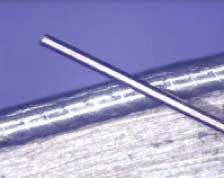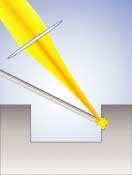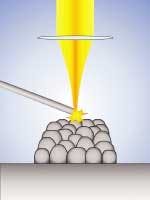Quicker fix
Forming, punching, or die casting tools undergo great strain in their every day use. Over time tolerances change because wear or damage is inevitable. Conventional repair methods, such as TIG welding, are time-consuming and costly, often producing distortion, softening, and the formation of cracks, which can limit its choice in certain applications. And frequently the final result does not meet the high quality standards of the tool and mold making industry. Components that have been produced in a refurbished mold may even fail the strict quality tests performed by the end customer. As a result, the mold must be replaced.
The solution for these constraints and problems is laser deposit welding (see Figure 1), which can be done on site, requiring a minimum of pre- and post-processing, while achieving material qualities that are equal to the original product when new.
Advantages of laser welding
The energy in the laser beam welds a hand-guided filler wire onto the workpiece with great accuracy and high strength. Wires with a diameter as small as 100 microns can be processed—clear evidence of the unrivaled high accuracy of this technology. A low heat-affected zone, rapid heating and cooling in the fushion area, and exact control of the beam power via pulse shaping are factors that provide a minimum thermal load on the workpiece. For crack-sensitive materials the mold is not pre-heated. Processing is spot-accurate, even in small geometries and places where access is difficult (see Figure 2). A unique tilt-adjustable optical system lets you work on vertical surfaces without rotating or tilting the mold. The accuracy of laser deposit welding saves complex post-processing with the milling machine. In many cases, finishing of the seam weld with a drawing die suffices.
Laser vs. TIG and micro-plasma welding
Laser welding is compatable with base materials up to 64 HRC. It can repair damage, locally improve wear resistance, and correct production defects with a quality that can be achieved only with laser deposit welding. The micro-structural transformation is much lower than with other technologies. Through the use of filler materials with a high melting point, significantly better layer properties are obtained. Laser deposit welding guarantees high-quality repairs, which are fully recognized by the customer as the appropriate method due to the high standard of laser welding.
Damaged or worn molds need no longer be thrown away and there is no complicated, costly, and time-consuming tool transport to the repair shop, nor external repair costs. So non-productive downtime can be reduced. Response time to design changes and modifications can be reduced. And, last but not least, laser technology is a new future-oriented competence center. Experience has shown that a deposit laser welding system pays for itself after only 1–2 years-even with only a few applications.
Laser units such as Rofin Baasel's StarWeld Tool Open with 150 W/100 J are ideal for welding aluminium and copper. This class IV system opens up new frontiers in laser welding by bringing the laser to the workpiece where repair work can be done on site, directly on the machine without costly disassembling.
Large access doors and a solid and precise motor-driven XY-table allow the StarWeld Tool Integral to take workpieces with a 50cm edge length and a maximum weight of 350 kg: this allows large tools and molds to be processed efficiently by the laser. The patented swivelling optics (see Figure 4) that can be swivelled around two axes allows processing of vertical surfaces, undercuts and deep grooves without rotating or tilting the workpiece. Thus setup times can be reduced.
Contact Thomas Renner at Rofin/Baasel Lasertech, e-mail: [email protected].




